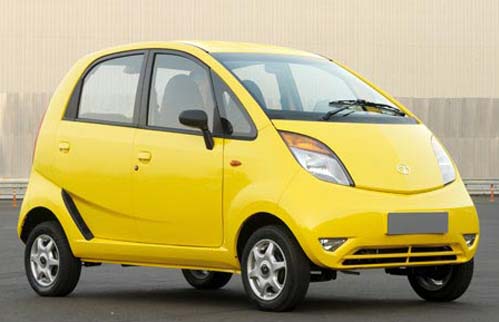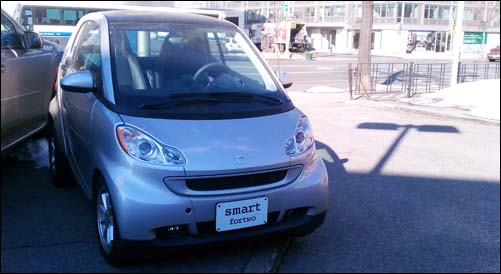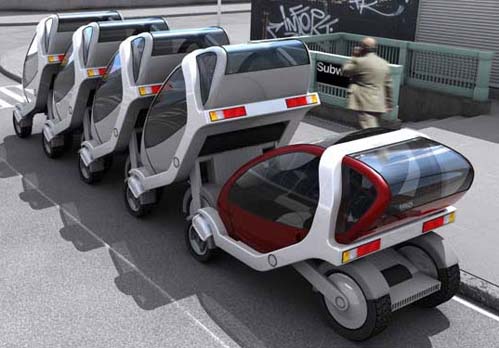The Nano, India's popular tiny car, has created an explosion of interest due to its low emissions, great gas mileage, and small overall footprint. Could smaller cars like the Nano be a solution for traffic-clogged streets and the problems of air pollution? Or are they a distraction from the real solutions? Planetizen's Emily Laetz investigates.
For hundreds of thousands of people in India's growing middle class, the Tata Nano looked great on paper: a fuel efficiency of close to 50 miles per gallon, a zippy 33 horsepower engine, and a shockingly low starting price – all packaged into a car that is barely 11 feet long. Even more importantly, it offered what seems like a safer mode of transportation for those used to navigating the notoriously chaotic street traffic of Indian metropolises such as New Delhi on motorized scooters.
However, as the country rapidly develops and the range of tiny personal automobiles on the market expands, a rash of technical problems involving the Nano's electrical and exhaust systems have arisen, while the Nanos have come to be viewed by many Indians as cheaply made and unfashionable. And larger questions loom in both the developed and developing worlds regarding the effects of widespread personal motorization on the environment and global energy demand. Environmentalists have become concerned about the effects of growing motorization on India, a nation whose urban mobility up to this point has largely been dependent on bicycles and low-emission scooters. Such drastic changes in the urban mobility of a large nation have many of them wondering, Is it possible that, in the near future, SUVs will be the next step for millions of people in countries such as India?
The rest of the world is taking notice. This month, a team of students and faculty from Cornell University's College of Architecture, Art, and Planning opens an exhibit titled "Unpacking the Nano," which references the tiny car model that Tata Motors began producing in June 2010. The automaker has sold hundreds of thousands of the cars in India for the approximate equivalent of 2500 U.S. dollars, a sticker price that made demand for the Nano outstrip supply for a while after its initial release. The exhibition and a related symposium, also at Cornell, aim to explore the design of the car and its potential impact while turning a critical eye to U.S. auto culture.
According to the exhibition's website, the Nano weighs just 1,322 pounds, exceeds European air quality standards, can reach speeds of approximately 65mph, and "promises safe transportation to the masses."
The vehicle's introduction has generated a wide variety of reactions from experts in fields ranging from international development to transportation planning.
"That $2500 is really cheap," said Ryan Chin, a lead researcher in the Smart Cities research group of the Media Laboratory at the Massachusetts Institute of Technology. "However, there are a couple of contradictions. It is gasoline-powered. I think that what India needs is not more cars on the road – they need more public transit. However, I think it is about a sense of pride in India, about safety."
Aleksandr Mergold, Visiting Assistant Professor of Architecture at Cornell, is co-directing Unpacking the Nano with Kent Kleinman, Dean of the university's College of Architecture, Art, and Planning. Mergold hopes that the exhibit and symposium on this tiny vehicle will inspire people to contemplate large questions, such as how best to balance competing demands for action on global climate change against claims to social equity.
"There's this argument on a moral ground that cars are bad, but who are we in the Western world to say that the Indian people should not buy cars like the Nano?" implied Mergold. "Should it really be about making a car that's affordable, that is safer to the middle class? The whole point of this exhibit is to ask questions."
Mergold claims that in order for India to reach the per-capita level of emissions in the U.S., millions of Nanos would have to be manufactured every year.
The Cornell exhibition's website boldly proclaims that, with 250,000 units produced in 2010 alone, the Nano's entrance into the marketplace "is the equivalent to the second coming of Ford's Model T." But will the arrival of the Nano stimulate such profound changes across the globe, even in countries like the U.S. where automobiles are already ubiquitous?
In 2009 Tata Motors unveiled a heavier, more expensive Nano in Europe that had been upgraded to meet the safety and emission standards of the European Union. But the carmaker has yet to introduce its models in the United States.

Tiny Cars and Carbon Emissions
Todd Litman, Executive Director of the Victoria Transport Policy Institute (VTPI), believes that the emissions-reducing role of tiny cars such as the Nano is exaggerated.
A paper he authored in 2009, titled "Efficient Vehicles Versus Efficient Transportation," details the relationships between four vehicle energy conservation strategies and their effects on annual vehicle travel, which in itself has a variety of associated mileage-related impacts on congestion, vehicle facility costs, and auto accidents. One of the paper's conclusions is that better fuel efficiency standards cause total vehicle travel to increase. This relationship, well known in economics as Jevons Paradox, states that increases in resource efficiency, in this case represented by the relative fuel efficiency of a tiny car as opposed to a traditional automobile, tend to increase the rate of consumption of that resource.
Litman is adamant that tiny cars don't serve the needs of everybody in metropolitan areas of developed nations such as the U.S. and Canada. While a developing nation such as India might lack a supply of inexpensive automobiles, which is the void that Tata Motors hopes to fill with its Nano, countries such as the U.S. and Canada already have a surplus of cheap vehicles in the form of used cars.
"Among all those problems there's a tendency for people to focus on a narrow set of problems," Litman said. "That's a reductionist approach and I think a reductionist approach is what got us into this in the first place. Going to tiny cars helps to address [affordability] but does very little to address the other concerns."
Litman goes on to point out that many groups of people – people who can't afford to buy a new car, those who can't drive for age-related reasons, families with multiple children, even tall people – won't be able to enjoy the benefits of a tiny car, and that an increase in personal automobile ownership in general may negatively impact important issues such as the high costs of road maintenance and health issues like obesity.
"Small cars legitimately don't serve everybody's needs," he said. "You're going to force the entire consumer market to buy a new, specialized car. So, in order to reduce congestion, you're increasing accident costs, increasing vehicle ownership costs, and you're doing something quite exclusive."
Litman thinks that cities would be better off pursuing the 'win-win' transportation solutions like walking and cycling improvements, smart growth land use policies, transit service improvements, and other measures that aim to support alternatives to the personal vehicle altogether. And given many Americans' reluctance to give up their personal vehicles, Litman approves of strategies that will incentivize people to drive less like pay-as-you-drive pricing, fuel taxes and tax shifting, HOV priority, commuter financial incentives and ridesharing. Litman can see a role for small cars if the pay scale was changed to allow a wider range of individuals to use them and if the vehicles are placed in a framework that emphasizes shared use.

Urbanism, Parking, and the Smart Car
So how would the Nano fit into the American market, and would the use of these tiny cars have a noteworthy impact? One way to predict the future is by considering the success of the most popular and iconic tiny car currently on the American market, made by Smart USA, a subsidiary of German-based automaker Daimler AG.
A Smart dealership brochure claims that the 2011 Smart Fortwo is "the ultimate expression of automotive efficiency." The Fortwo reportedly achieves 33 miles per gallon in the city and 41 miles per gallon on the highway, and the automaker states that its vehicle components are 95% recyclable at the end of their use cycle. The starting price for the 2011 'Pure Coupe' model is listed at $12,490, not including taxes and other fees.
"It's cute," says Washington, D.C. Smart Car driver Laura Johnston, explaining her primary motivation in purchasing the car.
Johnston noted that gas savings have been minimal in comparison to what she would spend on fuel for a traditional vehicle, but that easier access to street parking has been a huge benefit of owning a tiny car in the city, where a single spot can run upwards of $200 per month.
Johnston, an IT consultant living in the Northwest section of the District, ordered her Smart Fortwo Passion Coupe in the summer of 2007. A lengthy waiting list didn't allow her to drive the vehicle off the lot until nearly a year later, in July 2008, when she made it to the top of the list.
"If anything, the car has helped me out with living in the city," she said. "It puts public transportation options at my fingertips, as opposed to living far out in the suburbs and driving everywhere. It has enabled my city lifestyle to be more possible."
Smart USA is currently marketing parking benefits as a major advantage of driving a vehicle that is purportedly half the size of a traditional American sedan. For example, an arrangement with several New York City parking facility operators gives Smart drivers access to half-price parking at hundreds of lots and structures across the metropolitan area. Smart drivers even receive substantial parking discounts at the three major New York City airports: La Guardia, JFK International, and Newark.
The company is also working tirelessly to prove that safety is of the highest priority for drivers and passengers of its tiny cars. Presumably to allay fears amongst prospective owners, an entire section of the brand's website is devoted to showcasing safety features and 5-star crash ratings, while binders of safety information and photocopied newspaper articles with positive reviews of vehicle safety features are prominently featured in dealerships such as the Smart Center in Manhattan.
Even so, "I definitely wouldn't feel safe on the Beltway in rush hour traffic," stated Johnston, the Smart Car owner in Washington, D.C.
Johnston also noted that some of her friends and passengers don't always feel safe, but that in general she doesn't drive on many major highways and mostly gets around on city streets where speed limits rarely exceed 40 miles per hour.

Carsharing and Foldable Automobiles
Chin, of the Smart Cities research group at MIT, is quick to point out that a shared fleet of tiny cars stationed at various points around a city could offer a wide range of people a viable, affordable way to get around. The focus of Chin and his colleagues' work is on tiny "CityCars" that are lightweight, foldable, and electric. He claims that most of the expense in manufacturing a CityCar will stem from its software, not its hardware, and that its category of users would include occasional drivers, those who don't want to or are not able to pay for the maintenance and storage of their own automobile, and also those who are arriving from out of town without a vehicle.
"We believe that the concept of car sharing is democratizing," he said. "Small vehicles are making a comeback; we have all the gains for parking. Small will have its advantages and we don't want to make it exclusive. The goal is to make the cars accessible to people."
Still, Chin sees a positive role for these tiny, lightweight electric vehicles that extends far beyond their immediate emission reduction benefits. From a proactive point of view, he believes that trying to design an attractive vehicle that people want to use is the best solution to an array of complex urban problems, including noise pollution.
"With mass adoption of these vehicles, the city should even become much more quiet," he said. "What is the implication for street life if this is the case? I think that has a direct influence on vibrancy of cities."
Chin also pointed out that the development of a system that will both charge the CityCar and use its batteries as an intermediate energy storage destination between the vehicles and the power grid is currently underway at MIT and at a research center in the Basque region of Spain, where the CityCars are being built. Smart USA has also recently introduced an electric drive model, which can be plugged into a common household 110-volt electrical outlet and takes less than eight hours to charge to capacity.
Aside from these practical urban mobility and livability considerations, Chin and his MIT colleagues hope that tiny cars such as the CityCar will put something back into driving that has been missing for a while in the U.S. as urban traffic congestion worsens and commutes become more stressful: the fun factor.
"It's hard to have fun when you're in a traffic jam," he said. "We're going to have a pretty peppy car, and it has unique maneuvers. Our car also folds – in our vehicle, the whole car transforms. If we make the system work well, I don't think there's reason why people wouldn't think it's cool."
While the Nano may not be as sexy as MIT's CityCar, it is far more likely to make an appearance on these shores.
"The Nano is by no means romantic and symbolic – It is a means of transport, an efficient one," says Mergold as he prepares to open the Nano exhibit he curated. "The Nano changes the perception of the car as a symbol of freedom. You have to change the mindset."
Emily Laetz recently completed her internship with Planetizen. She received her undergrad in Urban + Environmental Planning from the University of Virginia in 2010. Her interests are transportation, design and environmental compliance, and she's spending this year deciding on her area of expertise and the university that will be the right fit for her.

Maui's Vacation Rental Debate Turns Ugly
Verbal attacks, misinformation campaigns and fistfights plague a high-stakes debate to convert thousands of vacation rentals into long-term housing.

Planetizen Federal Action Tracker
A weekly monitor of how Trump’s orders and actions are impacting planners and planning in America.

In Urban Planning, AI Prompting Could be the New Design Thinking
Creativity has long been key to great urban design. What if we see AI as our new creative partner?

King County Supportive Housing Program Offers Hope for Unhoused Residents
The county is taking a ‘Housing First’ approach that prioritizes getting people into housing, then offering wraparound supportive services.

Researchers Use AI to Get Clearer Picture of US Housing
Analysts are using artificial intelligence to supercharge their research by allowing them to comb through data faster. Though these AI tools can be error prone, they save time and housing researchers are optimistic about the future.

Making Shared Micromobility More Inclusive
Cities and shared mobility system operators can do more to include people with disabilities in planning and operations, per a new report.
Urban Design for Planners 1: Software Tools
This six-course series explores essential urban design concepts using open source software and equips planners with the tools they need to participate fully in the urban design process.
Planning for Universal Design
Learn the tools for implementing Universal Design in planning regulations.
planning NEXT
Appalachian Highlands Housing Partners
Mpact (founded as Rail~Volution)
City of Camden Redevelopment Agency
City of Astoria
City of Portland
City of Laramie


























